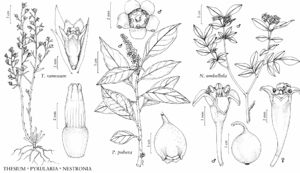Pyrularia pubera
Fl. Bor.-Amer. 2: 233. 1803.
Shrubs, rhizomatous, much branched, to 4 m; young growth minutely pilosulous. Petioles (5–)10(–19) mm. Leaf blades ovate-oblong, obovate, or elliptic, (4.2–)10(–21) × (2–)4(–8) cm, base acute to rounded, apex acute to acuminate, surfaces puberulent when young. Inflorescences: staminate terminal on axillary branches, erect, 3–8 cm, 15+-flowered; pistillate terminal or axillary, to 9-flowered; bracts caducous, pilose. Staminate flowers green, turbinate, 4 mm diam.; pistillode stigma above anthers. Pistillate flowers green, turbinate, 5–6 mm diam.; stigma at same height as staminode anthers. Pseudodrupes yellowish, pyriform or subglobose, 2–3 × 1–2 cm; exocarp splitting irregularly when mature, releasing mesocarp/seed. 2n = 38.
Phenology: Flowering May–Jul; fruiting Sep–Oct.
Habitat: Rich forests.
Elevation: 200–1400 m.
Distribution

Ala., Ga., Ky., N.Y., N.C., Pa., S.C., Tenn., Va., W.Va.
Discussion
Pyrularia pubera can be locally abundant in the Blue Ridge Mountains and Appalachian Plateau, often forming dense stands in second-growth forests. The species is apparently a host generalist (D. J. Leopold and R. N. Muller 1983) and has been reported to parasitize planted fir trees (Abies fraseri) in Virginia (L. J. Musselman and S. C. Haynes 1996). The seeds are very high in oil. Cytotoxic and antimicrobial peptides called thionins are present in P. pubera (L. P. Vernon et al. 1985).
Selected References
None.
